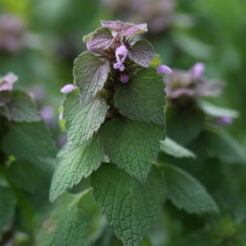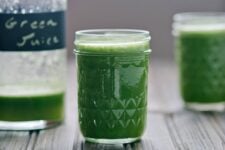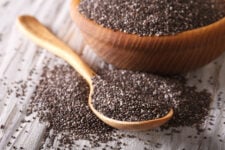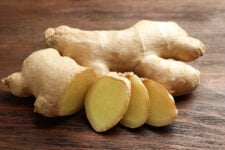Like dandelions and purslane, purple deadnettle is one of those weeds that seem to pop up just about everywhere. Its abundance earns it a bad rap with gardeners and often leads to it being pulled and tossed in the compost heap.
Before you pluck this common weed just to throw it away, you’ll want to read this.
Not only is purple dead nettle an important plant for pollinators, but it has a number of uses in the culinary and medicinal world. Some may call it a weed, but we consider it a versatile green that’s easy to grow and wonderful to look at. Keep reading to find out more about this plant, its many benefits and uses, and to see our favorite deadnettle recipes.
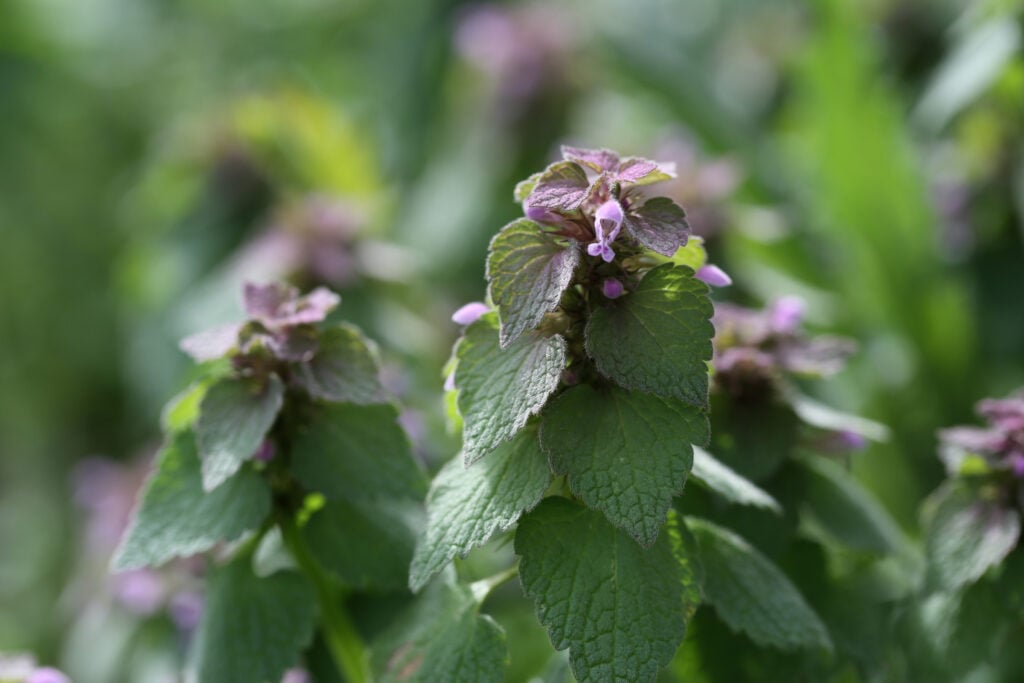
What Is Purple Dead Nettle?
Purple dead nettle, also known as red deadnettle, purple archangel, and Lamium purpureum, is a member of the mint family. Like other well-known species in this group, this plant has a square stem and triangular-shaped leaves. Unlike common mint, however, deadnettle doesn’t have that telltale minty flavor or smell.
The name comes from the resemblance of the leaves to those on stinging nettle plants. Because this weed lacks the irritating compounds of a true stinging nettle, it has been dubbed “dead” nettle. That is to say, this variety of nettle does not sting.
Like both true nettle and mint, deadnettle is edible. In the herbal world, it is widely considered a superfood and highly sought after by foragers.
Purple dead nettle is native to Europe and Asia but now grows abundantly in America. It is considered an invasive species, so propagation is frowned upon, but harvesting is very much encouraged.
Purple Dead Nettle Benefits
Purple deadnettle has a number of health benefits from a nutritional standpoint as well as a topical medicinal one. Here are just some of the many things this weedy herb offers.
- High nutritional value. Vitamin C, vitamin A, vitamin K, iron, and fiber are just some of the nutritional benefits this superfood plant brings to the table (source).
- Antioxidant properties. Purple dead nettle contains polyphenols, compounds with antioxidant properties that help support gut and cardiovascular health.
- Supports healthy immune function. Quercetin flavonoids found in deadnettle reduce the inflammatory reactivity of the immune system and counteract oxidation.
- Relieves allergy symptoms and reactivity. Quercetin also encourages histamine release to help reduce allergy symptoms. This paired with the anti-inflammatory and immune-supporting properties of the plant make it an especially powerful herb for those suffering from topical and respiratory seasonal allergies (source).
- Fights free radicals. Other flavonoids found in purple dead nettle have been shown to have even more powerful antioxidant effects than ascorbic acid.
- Reduces pain and inflammation. Deadnettle has been shown to inhibit the release of prostaglandins, which play a primary role in pain and inflammation, especially with regard to allergies and chronic inflammatory conditions (source).
- Antibacterial properties. This weed also contains phytochemicals known to have antibacterial properties and may be useful in fighting topical infections like staph and internal infections like E. coli.
- Antifungal properties. Dead nettle can also be used to fight candida infections both externally and internally.
- Supports healthy kidney function. Deadnettle is a diuretic and has been shown to help break up kidney stones and support renal function (source).
- Supports detoxification. This weed has diaphoretic properties and induces sweating to help clear toxins out of the body.
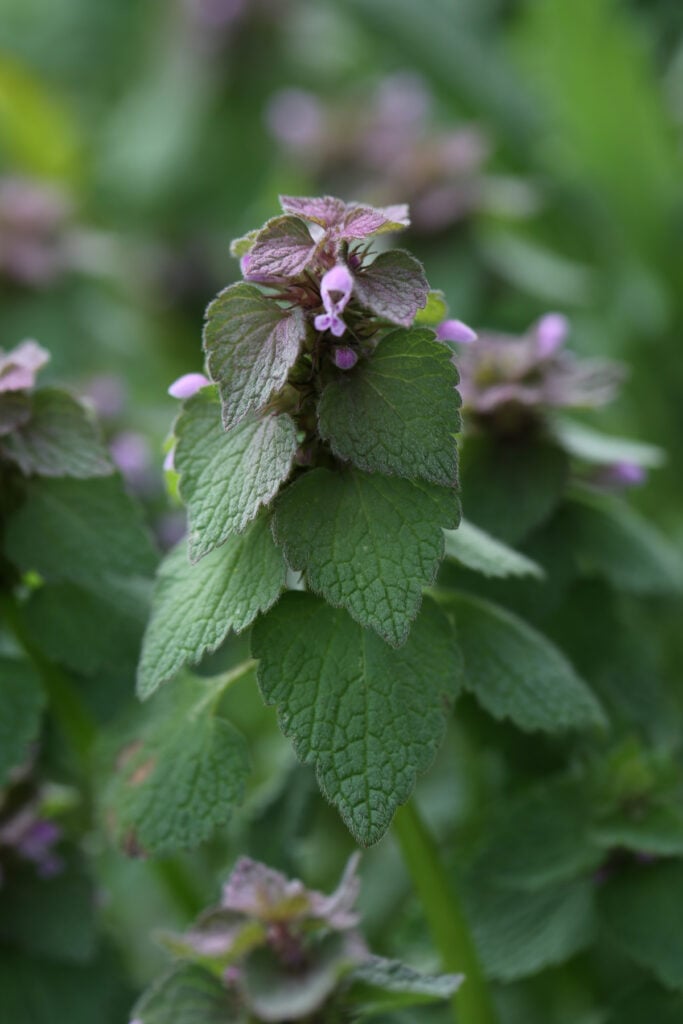
Purple Dead Nettle Uses
The leaves of this plant are packed with nutrition and make a great addition to salads and other raw dishes. Parts of the plant can also be used for medicinal applications and have some “magical” potential as well.
Medicinal
The benefits of purple dead nettle can be utilized internally as well as topically. For hundreds of years, people have been using this plant to create salves, tinctures, and teas to help a variety of ailments.
Salve
Purple deadnettle salves are great for treating a number of topical ailments. The antibacterial and antifungal properties of the plant make this application useful for minor cuts and wounds as well as rashes and skin infections.
Additionally, these topical balms are great for dry and cracked skin. They can also be used to relieve pain associated with inflamed joints, arthritis, and minor injuries.
Mixing in other helpful herbs like calendula, yarrow, and plantain can increase the usefulness of your dead nettle salve.
Check out this article for three great recipes for making your own purple nettle-infused oil and nettle salve right at home.
Tincture
Purple dead nettle tinctures are an easy way to get the benefits of this weed in a concentrated, easy-to-take form.
Making a purple dead nettle tincture is easy. Simply gather and wash your deadnettle leaves, chop them up, and place them in a glass jar. Then fill the jar until the leaves are covered with 180-proof grain alcohol.
Allow the mixture to sit in a dark, cool place for about 6 weeks, shaking occasionally. Once your tincture has finished setting, strain out the liquid into a glass bottle with a dropper applicator.
L. purpureum tinctures are useful for any of the conditions listed above but are especially great for treating allergies.
Tea
One of the easiest ways to take advantage of this nutritious and beneficial plant is to make tea with it.
Once you have dried nettle leaves, you can use them in a tea ball or bag and steep them as you would with traditional tea. Straight deadnettle tea has a grassy, earthy flavor. You can quickly improve on this by adding other dried leaves from the mint family, chamomile flowers, or your favorite herbs.
See the end of this article for our favorite simple deadnettle tea recipe.
Magical
This ancient plant has a lot of folklore and myths surrounding it. It has long been used in magical ceremonies to bring feelings of happiness, security, and grounding to the user. Just as this early-blooming plant overcomes obstacles with ease, it is said to offer the same power to those who wield it.
While there are no scientific studies confirming these long-held beliefs, we don’t think there’s any harm in using this wild plant in your spiritual ceremonies.
Purple Dead Nettle Foraging
You won’t find purple nettle at the grocery store, but you can usually track it down in one form or another at your local apothecary or herbalist. If that isn’t an option, you can find it growing wild in most US climates.
Where and When
It is hard not to stumble over dead nettle in the Northeast. It isn’t as common in other parts of the country but does grow just about everywhere in North America.
You can find purple dead nettle sprouting up in drainage ditches, along roadways, and where trees have been recently removed. These opportunistic weeds are often the first to pop up after land is cleared of other vegetation.
These annual medicinal plants sprout earlier in the spring than most native flora. They provide some of the first foraging opportunities of the season and are easiest to find in April and May. Their foliage dries and yellows in late spring but tends to rebound in the fall for a second opportunity for a harvest.
Identification
Like other mint plants, L. purpureum has an easily identifiable square stem. Unlike most mint, though, it does not have any noticeable minty scent or flavor.
Lower, mature dead nettle leaves are pale green while the top, newer leaves have a distinct purple tinge. The small hooded flowers are pale purplish pink. The deeply veined leaves are scalloped and have a broad, triangular shape and fuzzy texture.
The plants are fairly low-growing but can reach heights of 8 to 10 inches tall. Taller plants tend to have bare stocks below with leaves growing only on the taller portion.
Purple Dead Nettle Look-Alikes
Deadnettle looks very similar to other types of pale-leaved mint. The purple dead nettle leaves are not as broad or pointed as heirloom catnip. But the easiest way to differentiate between common mint varieties and deadnettle is through smell since these weeds lack that obvious mintiness.
Henbit (Lamium amplexicaule) is another mintless edible plant from the same family that shares some similar characteristics to deadnettle. These two weeds often grow side-by-side, further complicating identification.
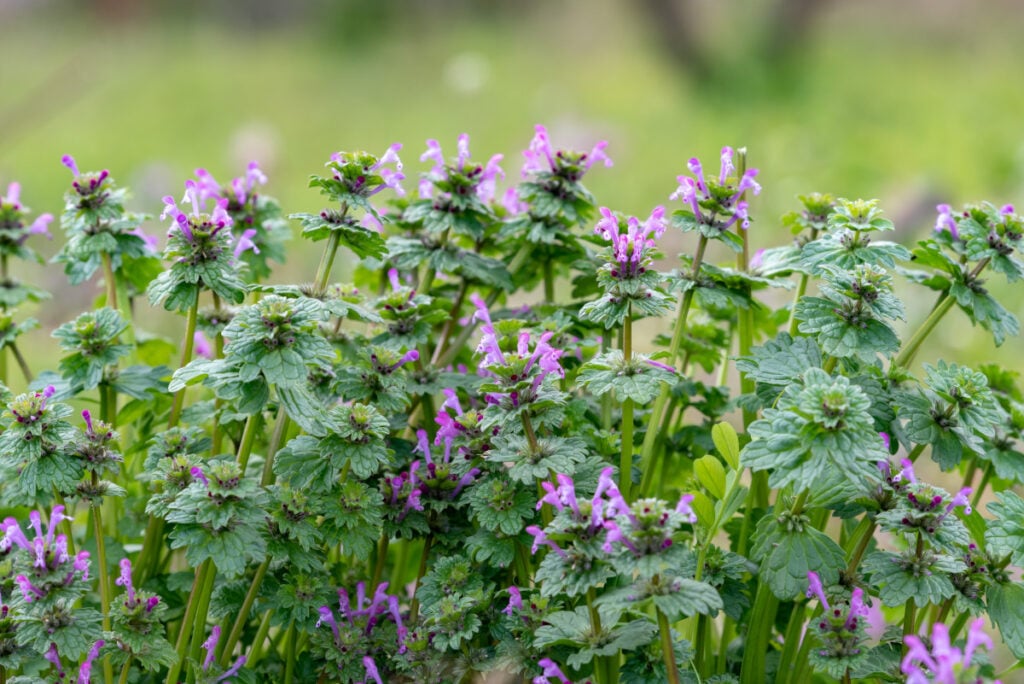
The leaves of henbit are round and grow in circles around the stem whereas deadnettle leaves are triangular and extend away from the stem.
Luckily, none of the purple dead nettle lookalikes are toxic. The only downside to mistaking one for the other would be missing out on all those great deadnettle benefits.
How to Dry Purple Dead Nettle
All ariel parts of deadnettle can be used to make salves, tinctures, and teas. For most applications, you’ll want to dry these pieces before use. Be sure to rinse the plants in cold water before preparing them. If there’s a chance the weeds were sprayed with any herbicides or chemicals, do not use them.
Start by separating the leaves, buds, and purple flowers from the stems. You can either throw the stems out or chop them into small pieces and dry them as well.
Spread your pieces over a drying screen or dry paper towels. Allow them to dry for several days. If using paper towels, stir the pieces occasionally to expose all sides to the open air.
Once the thickest piece crumbles in your hand when you crush it between your fingers, your deadnettle is dried and ready for use.
Purple Nettle Recipes
There are a ton of ways to use purple dead nettle as a medicinal herb, but there are also a lot of great ways to take advantage of this superfood’s nutritional qualities.
Here are some of our favorite ways to use dead nettle in the kitchen and some great purple deadnettle recipes.
Soups
Despite being in the mint family, deadnettle has more of a spinachy flavor. It is rich and earthy as you would expect any nutrient-rich green to be and makes a great addition or substitution in a variety of different soup recipes.
Some of our favorites include:
- Wild Purple Dead Nettle and Horsetail Soup – Swap out the butter for a vegan alternative and the heavy cream for coconut milk, and you’ve got yourself a delicious and nutritious plant-based soup.
- Purple Dead Nettle Soup – Here’s another great recipe that will take some tweaking to make vegan, but it can be done and is worth the effort!
Salads
Purple dead nettle leaves, especially young tender ones, make a great addition to any kind of greens-based salad. Topping them with a little oil-based dressing also helps your body utilize all the nutrients locked inside those leaves.
Smoothies
Smoothies are another great way to utilize purple dead nettle and take advantage of its many health benefits. Use these greens in place of spinach or kale in your go-to morning smoothie or try this great recipe:
- Purple Deadnettle Purple Smoothie – This simple smoothie only has five ingredients but is packed with protein and nutrients to energize your day.
Teas
Dry deadnettle leaves can be used on their own to make a nutritious, health-supporting tea. But if you want something with a little more flavor, try mixing your dried purple dead nettle with one or more of these more flavorful plants.
- Peppermint
- Hibiscus
- Lemon balm
- Chamomile
- Lavender
One thing to be aware of with dead nettle tea is that it can have a laxative effect if taken in large quantities. Unless that’s your goal, limit your intake to just one or two cups a day.
And More!
This herb can also be cooked and added to many of your favorite dishes in place of other greens. Just be sure not to overcook or you’ll risk destroying the nutrients that make this wild herb so useful.
Here are a few of our favorite savory deadnettle recipes:
- Purple Dead Nettle Rice Bake – This rice bake is absolutely delicious and easy to make vegan by substituting non-dairy cheese and milk.
- Purple Dead Nettle Pilaf – Substitute vegan butter and vegetable broth to make this savory recipe vegan. And don’t forget to add the purple deadnettle flowers to the final product for a recipe that looks as good as it tastes!
- Chickweed Pesto – Add purple deadnettle as well as other wild-foraged weeds to this tasty pesto recipe for an even deeper, richer flavor.
Purple Dead Nettle Tea
Ingredients
- 1 cup hot water near boiling
- 2 tsp dried purple dead nettle leaves
- 1 tsp honey
- dash vanilla extract
Instructions
- Add dried deadnettle to hot water and allow to steep for 5 minutes
- Strain out leaves.
- Mix in honey and vanilla extract and enjoy!
Notes
- For a more flavorful tea, mix 1 teaspoon purple deadnettle with 1 teaspoon mint, lemon balm, or your preferred dry tea or herb.
- If mixing teas, especially mint, you may want to skip the vanilla addition.
- The leaves are edible so feel free to skip the straining step.

